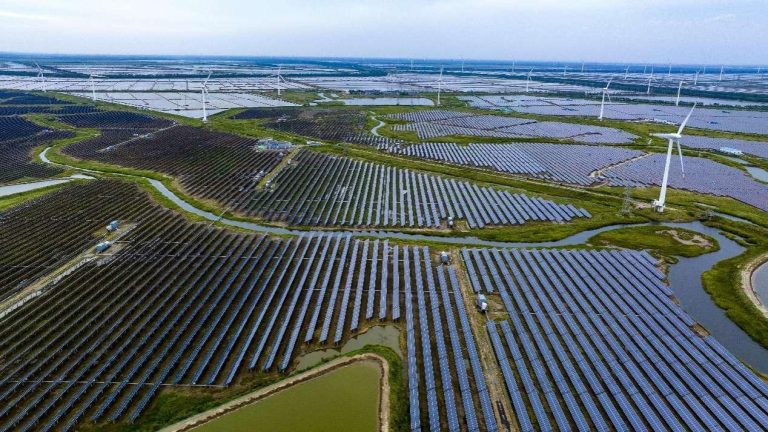
According to Cui Yan, Juncao, which means “mushroom and grass” and can be used to grow edible mushrooms, has a strong capability to fix and store carbon.
Recently, a Juncao program was launched in Yancheng, east China’s Jiangsu province to explore an integrated resource recycling model and set up an experimental base covering over 10 hectares.
The program, initiated under the cooperation between Jiangsu province and southeast China’s Fujian province, introduced improved Juncao varieties from Fujian and grew them on mud flats in Yancheng. It serves as a vivid example, replicating successful experiences in achieving China’s “dual carbon” goals.
According to a recent plan issued by the National Development and Reform Commission, China will launch carbon-peaking pilot projects in 100 cities and zones nationwide to solve bottlenecks constraining the country’s green and low-carbon development.
Resource endowments and development foundations vary across different regions. The carbon-peaking pilot projects aim to stimulate different regions’ initiative and creativity and accelerate the green transformation of development models by launching pilot tasks, implementing key projects, as well as innovating policies and mechanisms.
The projects aim to explore carbon-peaking pathways for different cities and zones and provide operable, replicable, and promotable experiences for the whole country, thus contributing to achieving carbon-peaking and neutrality goals.
These pilot projects are pioneers in achieving “dual carbon” goals. They make attempts to explore and provide solutions for cities or zones facing similar situations.
They are carried out in economically advanced and major energy-consuming provinces, such as Jiangsu, Shandong, and Guangdong, as well as in areas rich in traditional and new energy resources including Shanxi, Inner Mongolia, and Shaanxi.
The pilot plan determines goals and tasks by considering the geographical features, functional orientations, resource endowments, and development foundations of different regions, which will help explore diversified pathways to green and low-carbon transformation.
These projects, starting from certain regions, aim to find the universal principles for and play a role model in achieving carbon peaking and neutrality nationwide.
Many piloted regions have already made positive attempts. For instance, Inner Mongolia has been striving to establish a national ecological carbon sink supply base; factories in Anhui are promoting green manufacturing; offshore wind power generation has become a highlight along the 4,000-kilometer coastline in Guangdong.
In addition to the pioneering efforts to achieve “dual carbon” goals, piloted regions have also deepened reforms in strengthening sci-tech innovation, improving policy mechanisms, and enhancing public participation. As a result, a batch of innovative measures and experiences in reforms have been generated.
As the largest developing country, China faces the ambitious target of completing the world’s most dramatic reduction in carbon emission intensity and realizing carbon neutrality from carbon peaking in the shortest time in global history. In this process, leveraging the role played by these pilot projects can help explore the optimal path at a relatively lower cost.
These pilot projects carried out in small scopes and at the primary level, are explorations with controllable risks and tremendous space for innovation. They can stimulate people’s pioneering spirit and find rich, effective, and differentiated pathways.
The successful experiences gained through these grassroots projects will then be promoted on a larger scale with the country’s governance resources.
The positive interaction and organic combination of top-level design and primary-level exploration has enabled China to form a dynamic cycle that involves initial trials, result analysis, and promotion of successful experiences, which lowers risks and improves efficiency.
Statistics show a steady decline in the proportion of coal in China’s primary energy consumption – 68.5 percent in 2012, 60.6 percent in 2017, and 56.2 percent in 2022.
At the same time, China’s new energy vehicle ownership has seen significant annual growth – 220,000 in 2014, 1.53 million in 2017, and 13.1 million in 2022.
These figures mirror the strong momentum of green development in China, the world’s second-largest economy. Guided by the carbon-peaking pilot projects, innovative explorations are taking place nationwide, and a beautiful picture outlined by “dual carbon” goals is unfolding.










